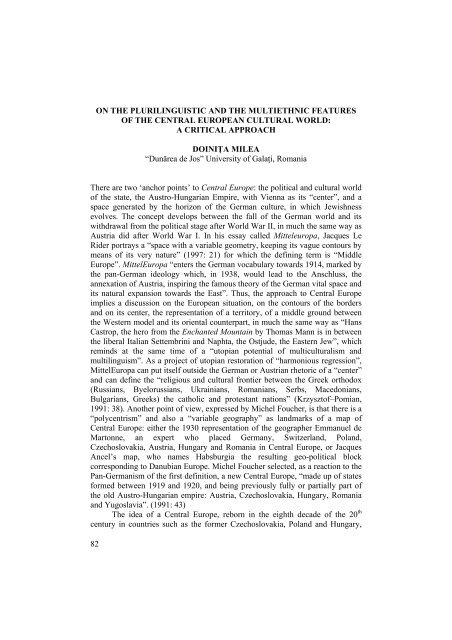culture, subculture and counterculture - Facultatea de Litere
culture, subculture and counterculture - Facultatea de Litere
culture, subculture and counterculture - Facultatea de Litere
You also want an ePaper? Increase the reach of your titles
YUMPU automatically turns print PDFs into web optimized ePapers that Google loves.
ON THE PLURILINGUISTIC AND THE MULTIETHNIC FEATURES<br />
OF THE CENTRAL EUROPEAN CULTURAL WORLD:<br />
A CRITICAL APPROACH<br />
DOINIŢA MILEA<br />
“Dunărea <strong>de</strong> Jos” University of Galaţi, Romania<br />
There are two ‘anchor points’ to Central Europe: the political <strong>and</strong> cultural world<br />
of the state, the Austro-Hungarian Empire, with Vienna as its “center”, <strong>and</strong> a<br />
space generated by the horizon of the German <strong>culture</strong>, in which Jewishness<br />
evolves. The concept <strong>de</strong>velops between the fall of the German world <strong>and</strong> its<br />
withdrawal from the political stage after World War II, in much the same way as<br />
Austria did after World War I. In his essay called Mitteleuropa, Jacques Le<br />
Ri<strong>de</strong>r portrays a “space with a variable geometry, keeping its vague contours by<br />
means of its very nature” (1997: 21) for which the <strong>de</strong>fining term is “Middle<br />
Europe”. MittelEuropa “enters the German vocabulary towards 1914, marked by<br />
the pan-German i<strong>de</strong>ology which, in 1938, would lead to the Anschluss, the<br />
annexation of Austria, inspiring the famous theory of the German vital space <strong>and</strong><br />
its natural expansion towards the East”. Thus, the approach to Central Europe<br />
implies a discussion on the European situation, on the contours of the bor<strong>de</strong>rs<br />
<strong>and</strong> on its center, the representation of a territory, of a middle ground between<br />
the Western mo<strong>de</strong>l <strong>and</strong> its oriental counterpart, in much the same way as “Hans<br />
Castrop, the hero from the Enchanted Mountain by Thomas Mann is in between<br />
the liberal Italian Settembrini <strong>and</strong> Naphta, the Ostju<strong>de</strong>, the Eastern Jew”, which<br />
reminds at the same time of a “utopian potential of multiculturalism <strong>and</strong><br />
multilinguism”. As a project of utopian restoration of “harmonious regression”,<br />
MittelEuropa can put itself outsi<strong>de</strong> the German or Austrian rhetoric of a “center”<br />
<strong>and</strong> can <strong>de</strong>fine the “religious <strong>and</strong> cultural frontier between the Greek orthodox<br />
(Russians, Byelorussians, Ukrainians, Romanians, Serbs, Macedonians,<br />
Bulgarians, Greeks) the catholic <strong>and</strong> protestant nations” (Krzysztof–Pomian,<br />
1991: 38). Another point of view, expressed by Michel Foucher, is that there is a<br />
“polycentrism” <strong>and</strong> also a “variable geography” as l<strong>and</strong>marks of a map of<br />
Central Europe: either the 1930 representation of the geographer Emmanuel <strong>de</strong><br />
Martonne, an expert who placed Germany, Switzerl<strong>and</strong>, Pol<strong>and</strong>,<br />
Czechoslovakia, Austria, Hungary <strong>and</strong> Romania in Central Europe, or Jacques<br />
Ancel’s map, who names Habsburgia the resulting geo-political block<br />
corresponding to Danubian Europe. Michel Foucher selected, as a reaction to the<br />
Pan-Germanism of the first <strong>de</strong>finition, a new Central Europe, “ma<strong>de</strong> up of states<br />
formed between 1919 <strong>and</strong> 1920, <strong>and</strong> being previously fully or partially part of<br />
the old Austro-Hungarian empire: Austria, Czechoslovakia, Hungary, Romania<br />
<strong>and</strong> Yugoslavia”. (1991: 43)<br />
The i<strong>de</strong>a of a Central Europe, reborn in the eighth <strong>de</strong>ca<strong>de</strong> of the 20 th<br />
century in countries such as the former Czechoslovakia, Pol<strong>and</strong> <strong>and</strong> Hungary,<br />
82












